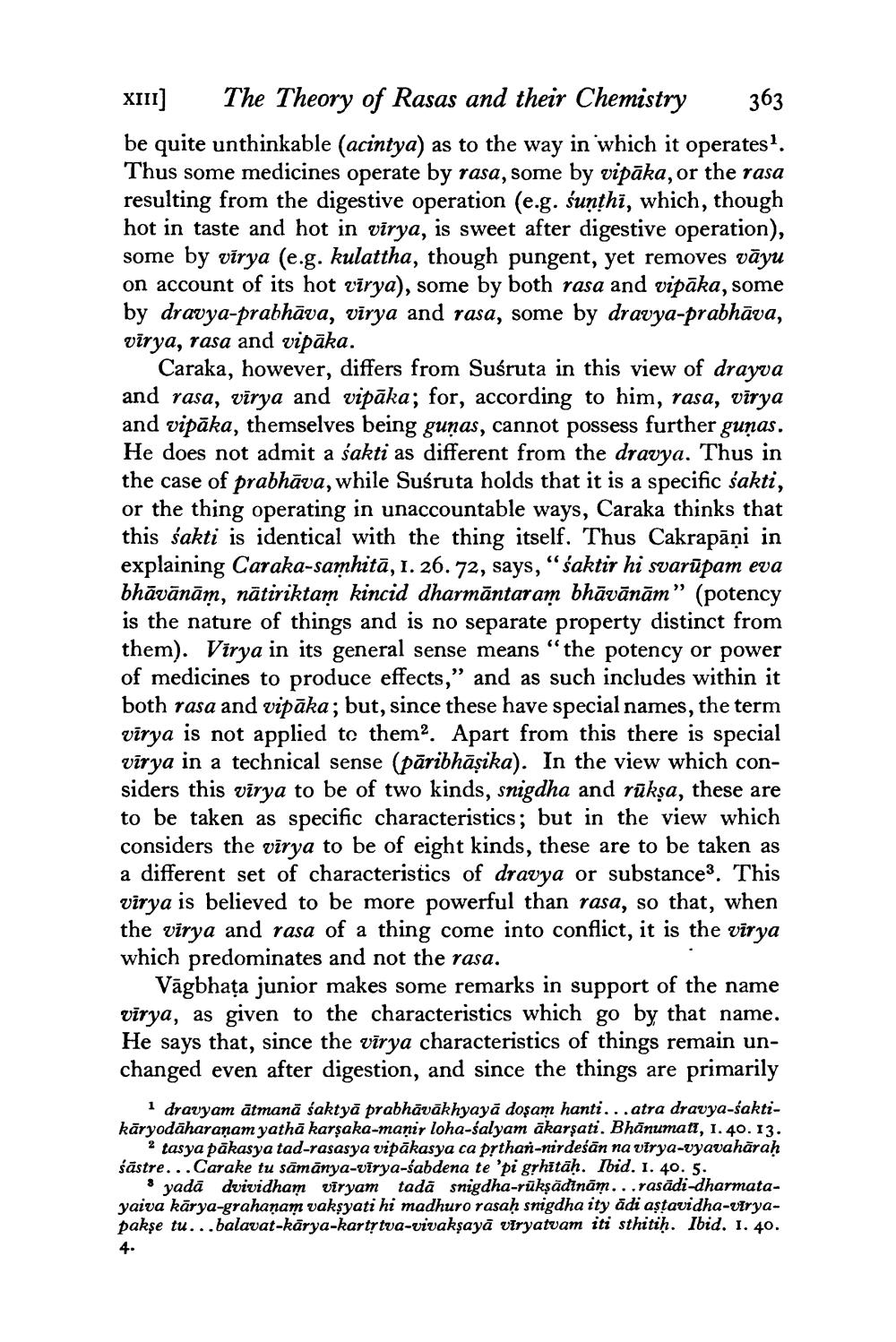________________
XIII] The Theory of Rasas and their Chemistry 363 be quite unthinkable (acintya) as to the way in which it operates?. Thus some medicines operate by rasa, some by vipāka, or the rasa resulting from the digestive operation (e.g. sunthi, which, though hot in taste and hot in vīrya, is sweet after digestive operation), some by vīrya (e.g. kulattha, though pungent, yet removes vāyu on account of its hot virya), some by both rasa and vipāka, some by dravya-prabhāva, vīrya and rasa, some by dravya-prabhāva, vīrya, rasa and vipāka.
Caraka, however, differs from Suśruta in this view of drayva and rasa, virya and vipāka; for, according to him, rasa, virya and vipāka, themselves being guņas, cannot possess further guņas. He does not admit a sakti as different from the dravya. Thus in the case of prabhāva, while Suśruta holds that it is a specific sakti, or the thing operating in unaccountable ways, Caraka thinks that this sakti is identical with the thing itself. Thus Cakrapāņi in explaining Caraka-samhitā, 1. 26.72, says, “saktir hi svarūpam eva bhāvānām, nātiriktam kincid dharmāntaram bhāvānām” (potency is the nature of things and is no separate property distinct from them). Virya in its general sense means "the potency or power of medicines to produce effects,” and as such includes within it both rasa and vipāka; but, since these have special names, the term vīrya is not applied to them?. Apart from this there is special vīrya in a technical sense (paribhāşika). In the view which considers this vīrya to be of two kinds, snigdha and rūkşa, these are to be taken as specific characteristics; but in the view which considers the vīrya to be of eight kinds, these are to be taken as a different set of characteristics of dravya or substance?. This vīrya is believed to be more powerful than rasa, so that, when the virya and rasa of a thing come into conflict, it is the virya which predominates and not the rasa.
Vāgbhața junior makes some remarks in support of the name vīrya, as given to the characteristics which go by that name. He says that, since the vīrya characteristics of things remain unchanged even after digestion, and since the things are primarily
1 drauyam ātmanā saktyā prabhāvākhyayā doşam hanti...atra dravya-saktikāryodāharanam yathā karşaka-manir loha-salyam akarşati. Bhānumati, 1.40.13.
2 tasya pākasya tad-rasasya vipākasya ca prthan-nirdeśān na virya-vyavahāraḥ śāstre... Carake tu sāmānya-vīrya-sabdena te 'pi grhītah. Ibid. 1. 40. 5.
8 yadā dvividham vīryam tada snigdha-rükşādinām...rasādi-dharmatayaiva kārya-grahanam vakşyati hi madhuro rasaḥ snigdha ity ādi aștavidha-viryapakşe tu...balavat-kārya-kartytva-vivakşayā viryatvam iti sthitiḥ. Ibid. 1. 40.
asádividha-cr. 40




